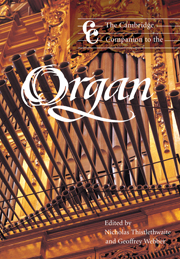Book contents
- Frontmatter
- Part I The instrument
- Part II The player
- Part III Selected repertoires
- 10 Italian organ music to Frescobaldi
- 11 Iberian organ music before 1700
- 12 The French classical organ school
- 13 English organ music to c1700
- 14 Catholic Germany and Austria 1648–c1800
- 15 The north German organ school
- 16 The organ music of J. S. Bach
- 17 German organ music after 1800
- 18 French and Belgian organ music after 1800
- 19 British organ music after 1800
- 20 North American organ music after 1800
- Appendix: The modes (toni) and their attributes according to Zarlino
- Notes
- Bibliography
- Index
19 - British organ music after 1800
from Part III - Selected repertoires
Published online by Cambridge University Press: 28 September 2011
- Frontmatter
- Part I The instrument
- Part II The player
- Part III Selected repertoires
- 10 Italian organ music to Frescobaldi
- 11 Iberian organ music before 1700
- 12 The French classical organ school
- 13 English organ music to c1700
- 14 Catholic Germany and Austria 1648–c1800
- 15 The north German organ school
- 16 The organ music of J. S. Bach
- 17 German organ music after 1800
- 18 French and Belgian organ music after 1800
- 19 British organ music after 1800
- 20 North American organ music after 1800
- Appendix: The modes (toni) and their attributes according to Zarlino
- Notes
- Bibliography
- Index
Summary
In 1812, A. F. C. Kollmann, the German-born theorist and organist at the Royal German Chapel, St James's Palace, summarised the state of organ music in Britain as follows:
Though very fine compositions for the organ have been published by Mr. S. Wesley, and by other able masters, they are still for manual keys only, and the use of obligato [sic] pedals is not yet promoted by them. But a true idea of the latter begins now to become pretty general, by increasing circulation of Sebastian Bach's Organ Trios, and of other works for the Organ, published by Messrs. S. Wesley and Horn.
(Kollmann 1812: 15)Kollmann's expression of confidence in Bachian textures as models for the future development of a British organ repertoire is not surprising given his profound interest in his countryman's music. He found it remarkable, however, that despite London's importance as ‘the most opulent city on the face of the globe’, there was not a single instrument equal to the organs of Germany and the Netherlands, and that even some of the most populous and richest churches in England lacked an organ. He further lamented the general inadequacy of an organist's remuneration and concluded that organ playing as a ‘particular study’ was not encouraged as on the continent (Kollmann 1812: 21).
Kollmann's thirty-year residency in London notwithstanding, the typical British organ must have remained ineffectual in his opinion when compared with the continental giants at Haarlem, Weingarten and Hamburg (Michaeliskirche), and the laissez-faire attitudes to the art of organ playing perplexing. The extant 1764 John Byfield organ at St Mary’s, Rotherhithe (restored by Noel Mander in 1959; see Figure 5.9, p. 69) provides an excellent opportunity to see what Kollmann knew as a large indigenous organ around the time of his arrival, an instrument fully commensurate with the full and solo-stop voluntaries of Stanley, Boyce, Walond and their imitators then in circulation.
- Type
- Chapter
- Information
- The Cambridge Companion to the Organ , pp. 279 - 298Publisher: Cambridge University PressPrint publication year: 1999



